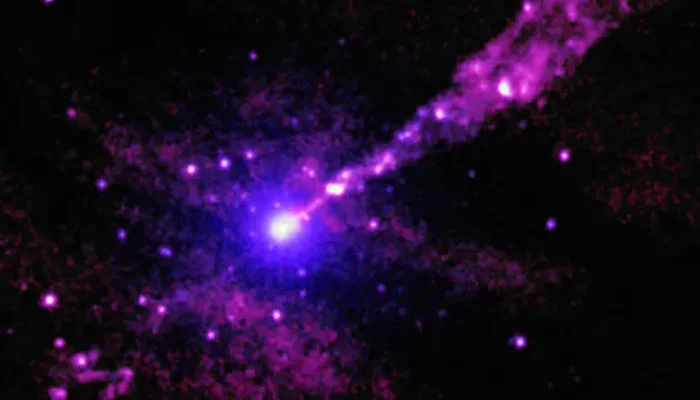Astronomers have discovered remarkably powerful X-ray jets emanating from two supermassive black holes that are so ancient they shine brightly in the afterglow of the Big Bang. “They are transforming the first light of the universe into high-energy jets,” stated Jaya Maithil, a postdoctoral research fellow at the Harvard & Smithsonian Center for Astrophysics, while speaking to reporters on June 9 at the 246th meeting of the American Astronomical Society in Anchorage, Alaska, as reported by Space.com.
Utilizing data from NASA’s Chandra X-Ray Observatory and the Karl G. Jansky Very Large Array (VLA), Maithil and her team found that each jet extends an astonishing 300,000 light-years—a distance nearly three times the diameter of our Milky Way galaxy. Each of these colossal jets originates from an actively feeding supermassive black hole, commonly known as a quasar, situated approximately 11.6 billion and 11.7 billion light-years away from Earth.
The researchers observed these immense structures as they existed when the universe was merely 3 billion years old, a period characterized by the rapid growth of both galaxies and their central black holes. “These quasars are like cosmic time capsules,” Maithil commented. “If we understand them, we can understand how they were impacting the growth of their galaxy and the environment in which they resided.”
One of the newly discovered jets, specifically from a quasar designated J1610+1811, is clearly visible in the accompanying Chandra image. A slender, faint purple line extends from the quasar’s brilliant white core, reaching towards the upper right and terminating in a small, bright blob. A second, dimmer jet appears to project in the opposite direction, extending downward and to the left.
Maithil described the challenge of observing these faint structures across such vast cosmic distances, comparing it to “looking for candlelight in close vicinity to a flashlight that’s blazing toward us.”
What makes these jets particularly noteworthy is their visibility across billions of light-years. In a paper accepted for publication in The Astrophysical Journal, Maithil and her team propose that the jets emit X-rays due to their interactions with the cosmic microwave background (CMB)—the faint relic radiation from the Big Bang that persisted after the universe had cooled sufficiently for starlight to travel freely, marking the end of the “cosmic dark ages.”



